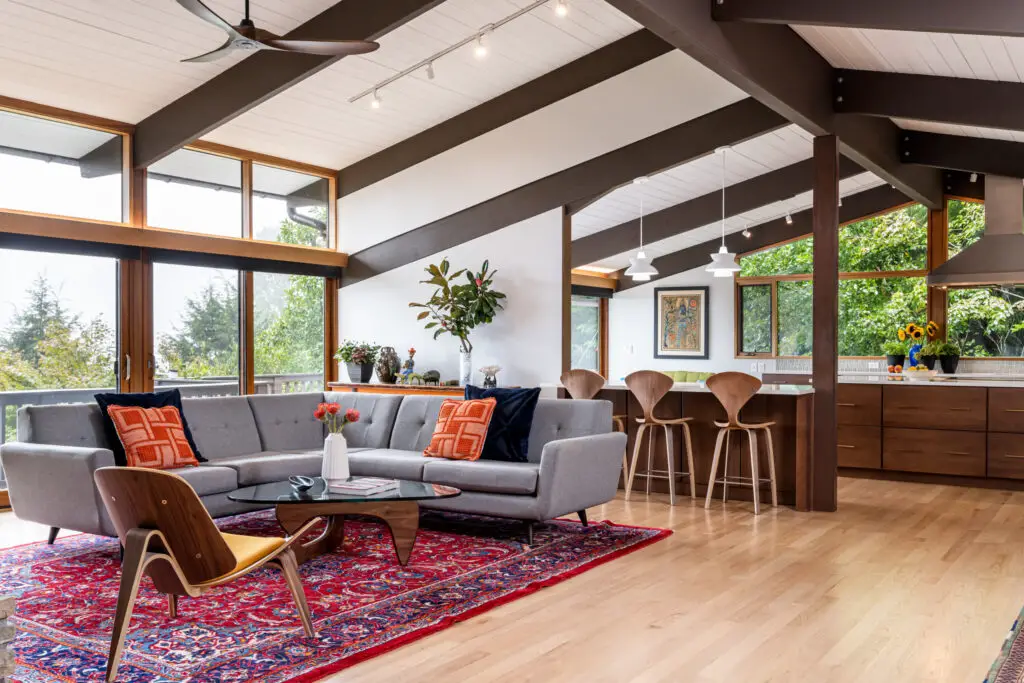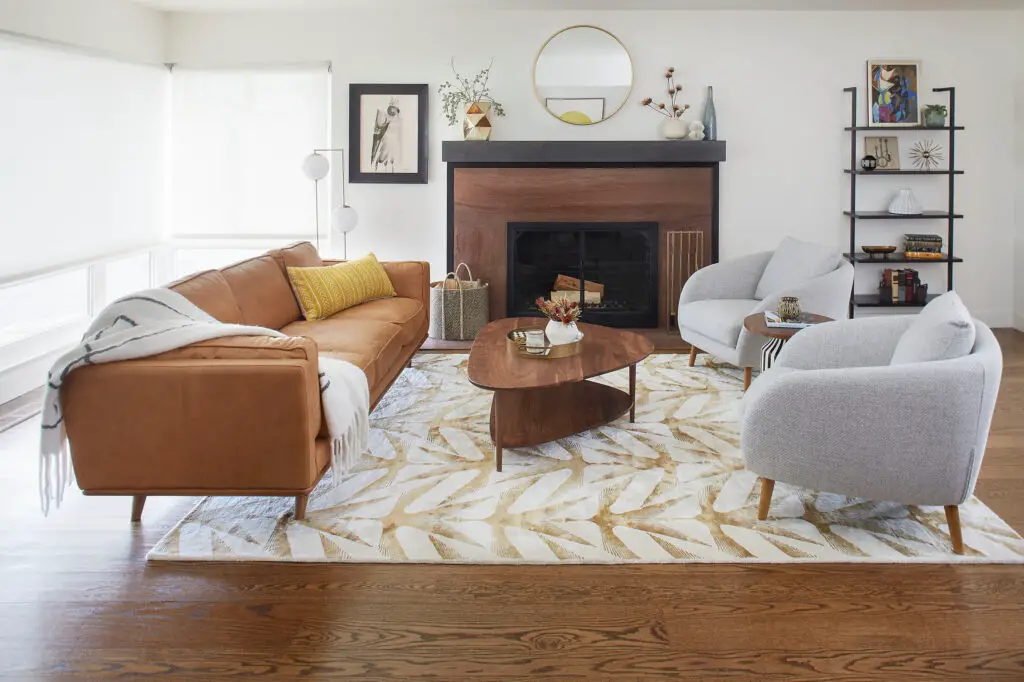
Introduction: The Art of Blending Mid-Century Modern with Contemporary Design
Welcome to the world of design fusion, where two contrasting styles come together to create a harmonious and visually captivating space. The Art of Mixing Styles: How to Blend Mid-Century Modern with Contemporary Design will take you on a journey to explore the magic of merging these two distinct design aesthetics. Whether you’re a design enthusiast, a homeowner, or an interior designer looking for inspiration, this guide will provide you with valuable insights and practical tips to master the art of blending Mid-Century Modern and Contemporary design seamlessly.
The Magic of Combining Mid-Century Modern and Contemporary Design
Mid-Century Modern and Contemporary design may seem like an odd couple at first glance, but when mixed strategically, they create a unique and eclectic style that exudes charm and sophistication. By combining the clean lines, organic shapes, and warm wood tones of Mid-Century Modern with the sleekness, simplicity, and neutral color palettes of Contemporary design, you can achieve a space that is both inviting and effortlessly stylish.
The Art of Mixing Styles: How to Blend Mid-Century Modern with Contemporary Design
Bringing together two different design styles requires careful thought and consideration. Let’s dive into the essential techniques and ideas that will help you master the art of blending Mid-Century Modern with Contemporary design.
1. Understanding the Key Characteristics
To create a successful fusion of Mid-Century Modern and Contemporary design, it’s crucial to grasp the key characteristics of each style:
Mid-Century Modern:
- Clean lines and organic shapes
- Use of natural materials like wood, leather, and metal
- Retro color palettes with bold hues and earthy tones
- Iconic furniture designs by renowned designers
Contemporary Design:
- Sleek and streamlined forms
- Emphasis on minimalism and simplicity
- Neutral color schemes with pops of bold colors
- Use of glass, steel, and concrete for a modern touch
By understanding these core elements, you can identify how to blend them harmoniously.
2. Creating a Cohesive Color Palette
One of the key aspects of successfully blending Mid-Century Modern with Contemporary design is establishing a cohesive color palette. Here are a few tips to help you achieve this:
- Neutral Base: Start with a neutral base color for the walls, such as white, beige, or light gray. This will provide a clean canvas for the furniture and accessories.
- Pops of Color: Introduce pops of color through accent pieces, such as pillows, rugs, or artwork. Opt for bold hues inspired by the Mid-Century Modern era to add vibrancy and personality to the space.
- Balance and Contrast: Maintain a balance between warm and cool tones. If you have predominantly warm wood tones in your Mid-Century Modern pieces, balance them with cool-toned Contemporary accessories or furniture in metal or glass.
3. Harmonizing Furniture and Accessories
When it comes to blending Mid-Century Modern with Contemporary design, finding the right balance between furniture and accessories is crucial. Here are some ideas to help you achieve a harmonious composition:
- Mixing Furniture Styles: Pair a Mid-Century Modern sofa with a sleek Contemporary coffee table, or combine a modern dining table with iconic Mid-Century Modern chairs. The key is to find pieces that complement each other and create a cohesive look.
- Accessorizing with Intention: Select accessories that bridge the gap between the two styles. For example, place a contemporary abstract sculpture on a Mid-Century Modern sideboard or display Mid-Century Modern ceramics on a sleek Contemporary shelving unit. These subtle touches will help tie the styles together.
- Embracing Contrasts: Don’t be afraid to embrace contrasts in materials and textures. Combine the smoothness of glass or metal with the warmth and natural beauty of wood. This juxtaposition will add visual interest and depth to your space.
4. Finding Common Ground in Lighting
Lighting plays a crucial role in any design scheme, and it can be used to bridge the gap between Mid-Century Modern and Contemporary styles. Consider the following tips when selecting lighting fixtures:
- Sleek and Simple: Choose contemporary lighting fixtures with clean lines and minimalist designs. Opt for fixtures made of glass, chrome, or brushed metal for a modern touch.
- Retro-inspired Lighting: Incorporate Mid-Century Modern-inspired lighting fixtures to add a nostalgic charm. Look for pendant lights or floor lamps with organic shapes and warm metal finishes.
- Mix and Match: Combine different styles of lighting fixtures throughout your space. For instance, you can hang a contemporary chandelier over a Mid-Century Modern dining table or place a retro-inspired table lamp on a contemporary side table. This combination will create an eclectic and visually dynamic ambiance.
5. Balancing the Scale and Proportions
Achieving a harmonious blend of Mid-Century Modern and Contemporary design also involves considering the scale and proportions of furniture and decor elements. Follow these guidelines to strike the right balance:
- Focal Points: Identify the focal points in your space and use them as anchors for each style. For example, if you have a Mid-Century Modern fireplace, let it be the star of the room and complement it with contemporary seating arrangements.
- Layering Heights: Create visual interest by layering different heights in your furniture and decor. Place low-profile Mid-Century Modern sideboards next to tall contemporary bookshelves or use a mix of high-backed and low-backed chairs around a dining table.
- Open Space: Embrace negative space and avoid clutter. Both Mid-Century Modern and Contemporary design appreciate open, airy spaces, so keep your layout uncluttered and allow each piece to shine individually.
6. Blending Patterns and Textures
Patterns and textures add depth and personality to a space. When blending Mid-Century Modern with Contemporary design, consider the following tips:
- Geometric Patterns: Incorporate geometric patterns, a common feature in both styles. Use Mid-Century Modern-inspired wallpaper with bold geometric prints as an accent wall, or introduce contemporary geometric patterns through rugs or throw pillows.
- Mixing Textures: Combine different textures to create a tactile experience. Pair the smoothness of leather or velvet upholstery with the sleekness of metal or glass surfaces. Add a touch of warmth with natural materials like wood or rattan.
- Balance in Scale: When using patterns, ensure there is a balance in scale. If you have a large-scale pattern on a Mid-Century Modern sofa, balance it out with smaller-scale patterns on Contemporary accent chairs or pillows.

The Art of Mixing Styles: FAQs
- Can I blend Mid-Century Modern with Contemporary design in a small space? Absolutely! In fact, blending these styles can work exceptionally well in smaller spaces. Opt for compact Mid-Century Modern furniture pieces and choose Contemporary designs with sleek lines to create an illusion of space.
- What if I already have Mid-Century Modern furniture? How can I incorporate Contemporary elements? If you already have Mid-Century Modern furniture, you can easily incorporate Contemporary elements to update the look. Add Contemporary accessories such as lamps, artwork, or rugs to bring a modern touch to the space. You can also mix and match Mid-Century Modern and Contemporary pieces by choosing complementary colors and materials.
- Are there any specific color palettes that work well for blending these styles? While there are no hard and fast rules, some color palettes work particularly well for blending Mid-Century Modern with Contemporary design. Consider using a neutral base of whites, grays, or beiges and adding pops of bold colors inspired by the Mid-Century Modern era. Think vibrant oranges, yellows, and blues. Remember to maintain a balance and harmony between warm and cool tones.
- Can I blend other design styles with Mid-Century Modern and Contemporary? Absolutely! Blending design styles is all about creativity and personal expression. You can experiment with incorporating elements of other styles like Scandinavian, Industrial, or Bohemian into your Mid-Century Modern and Contemporary fusion. Just ensure that there is a cohesive theme and that the styles complement each other.
- Should I focus on symmetry or asymmetry when blending these styles? Both symmetry and asymmetry can work well when blending Mid-Century Modern with Contemporary design. Mid-Century Modern tends to favor symmetrical arrangements, while Contemporary design often embraces asymmetry. You can play with both approaches, depending on your personal preference and the overall aesthetic you want to achieve. Mix symmetrical Mid-Century Modern furniture with asymmetrical Contemporary artwork or vice versa for an intriguing composition.
- How do I avoid creating a cluttered or chaotic look when blending these styles? To avoid a cluttered or chaotic look, it’s important to maintain a sense of balance and simplicity. Avoid overcrowding your space with too many furniture pieces or accessories. Choose statement pieces that represent the essence of each style and let them shine. Embrace negative space and allow each item to have room to breathe. Regular decluttering and editing will also help keep the space cohesive and visually pleasing.
Conclusion: Achieving Design Harmony
Blending Mid-Century Modern with Contemporary design is an art form that requires careful consideration and a keen eye for detail. By understanding the key characteristics of each style, creating a cohesive color palette, harmonizing furniture and accessories, finding common ground in lighting, balancing scale and proportions, and blending patterns and textures, you can achieve a space that seamlessly merges the best of both worlds.
Remember, there are no strict rules when it comes to design fusion. Let your creativity guide you as you experiment with different combinations and find what resonates with your personal style. The Art of Mixing Styles: How to Blend Mid-Century Modern with Contemporary Design offers endless possibilities to create a unique and captivating space that reflects your individuality.
So, go ahead and embark on your design journey, embracing the magic of blending Mid-Century Modern with Contemporary design. Let your imagination soar as you create a space that is a testament to your personal style and showcases the beauty of design fusion.
